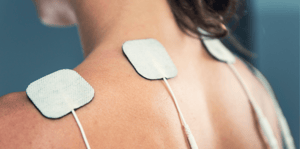Imagine if a doctor attempted to stick an electrode pad on you, only for it to sadly flutter down to the floor.
Most skin adhesives rely on a delicate balance between the ability to cling and conform to the body’s surface and stay loose enough to peel without causing pain. Because specific applications use different types of electrode pads, individual designs require unique stick-to-skin design considerations.
As a converter who’s helped bring hundreds of medical component designs into reality, Strouse often advises other businesses on optimizing products for manufacturability.
After all the work you’ve put into your design, it’s also worth preparing a smooth and painless manufacturing process. Today, you’ll learn tips that will help prepare you for your journey to find custom electrode pads.
What are Electrode Pads Used For?
Electrode pads are commonly used for pain relief in physical therapy, athletics, and individual treatment for ongoing conditions.
Electrode pads monitor and deliver electric currents to the body by dispersing the energy along the skin. The mild shock sent out by the electrode pads causes muscles to momentarily tense and relax, which can help relieve the patient's muscle and joint pain.
Tips for Electrode Pad Manufacturing and Design
Modern electrode pads are often made using conductive hydrogel or hydrocolloid material, which are easy to remove and gentle on the skin.
Converters will laminate to one side of the hydrogel or hydrocolloid for additional stability. Then, they’ll die cut the part component into the final shape, package it, and send it off for use. These tips should help you prepare for the production phase of your electrode pads.
1. CONSIDER YOUR DEMOGRAPHIC
Each patient demographic has skin that behaves a certain way, which you’ll need to consider to have a project with the best functionality.
For instance, neonatal and elderly patients are likelier to possess thin, delicate skin requiring softer, gentler products. Using the wrong type of adhesive on either of these age groups could result in skin damage that worsens the existing condition.
Medical tapes for sensitive skin will cling onto the skin but peel easily upon removal, mitigating the risk of damage.
Even a light-release acrylic is still tight compared to silicone skin adhesive. For this reason, gentle silicone adhesives are more suitable for patient demographics at a higher risk of torn skin.
2. KEEP YOUR PRICE POINT IN MIND
Medical products are precise by nature, so customers tend to know the exact materials and specifications they need. However, your product price can vary considerably based on the materials you choose.
When it comes to the price of skin adhesives, silicone is often 2-3x more expensive than acrylic.
Yet, with stick-to-skin applications, the adhesive quality is apparent to the end user based on the resulting marks or adhesive residue. An experienced converter will better understand whether the end result will be affected by material substitutions.
While you may already have an idea of what you’ll need, a converter can help you find better material product deals in the most efficient possible quantities.
3. SEEK PRODUCTION ADVICE/ASSISTANCE
Although you have an incredible electrode pad design, a large piece of your product’s success still depends on its manufacturing feasibility. You can prepare yourself for a smoother process by seeking expert advice and assistance in that area.
Flexible material converters will be able to advise you on critical production factors such as die cut tolerances and clean room usage.
Using materials like conductive hydrogel makes it challenging to hold die cut tolerances. Every die cut design has tolerances that dictate the acceptable deviation range for each part measurement.
Tight tolerances are more challenging to achieve on materials like hydrogel, which might be softer and thicker to cut. As a result, your design tolerances will likely be looser than those for film or paper. Your design tolerances might not be an issue if your design is a simple shape (which many electrode pads are). Still, because each product is different, the tolerances may be highly specific or challenging to achieve.
Another cost-relevant factor to consider is whether your part needs to be processed in a particle-reduced environment like a manufacturing clean room.
Electrode pads have adhesive laminated onto one side for skin adhesion. Businesses might opt to have their pads built in a clean room to prevent large particles from contaminating the adhesive. However, while this contributes to the cleanness, it also increases the cost of electrode pads.
Getting Started
Designing the electrode pads is only a small part of the big picture— but how do you develop a feasible plan to produce a sizeable quantity of clean and accurate products?
Inefficient manufacturing processes go further than cost; they can cause damage to your product quality, brand, and the trust of your investors.
From discussing your application to your future scaling goals, taking the first step with a converter will set you up for success. You can get started on an efficient production process by reaching out to a flexible material converter to discuss your design.
Do you want to learn more about medical manufacturing or die cut adhesive products? See our Learning Center for more articles and resources.
%20(1)-min.png?width=290&name=Untitled%20(52)%20(1)-min.png)






